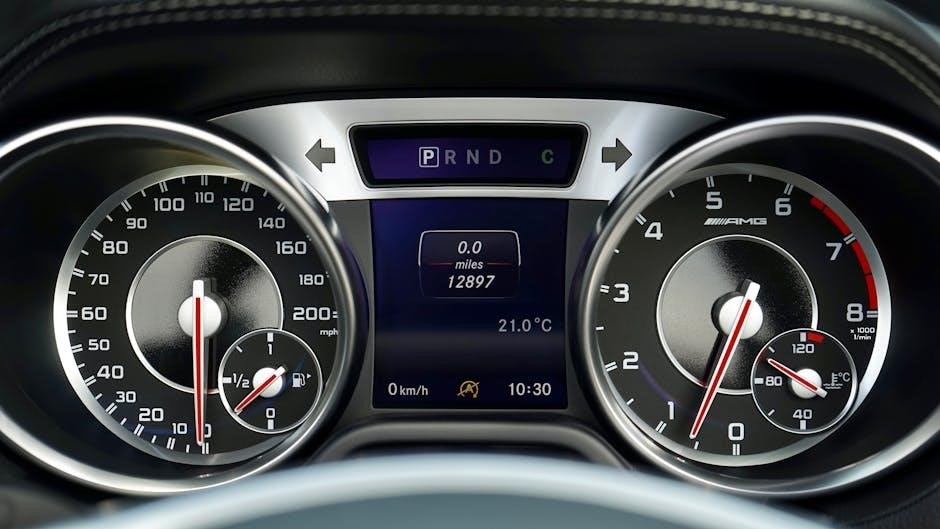The Isuzu D-Max dashboard symbols guide provides a comprehensive overview of warning lights and indicators, essential for safe and efficient driving. Understanding these symbols helps drivers interpret vehicle status, address potential issues promptly, and maintain optimal performance. This guide is perfect for both new and experienced D-Max owners, offering clear insights into dashboard notifications.
1.1 Importance of Understanding Dashboard Symbols
Understanding Isuzu D-Max dashboard symbols is crucial for safe and efficient driving. These symbols provide vital information about your vehicle’s status, helping you identify potential issues early and avoid costly repairs. Recognizing warning lights ensures proper maintenance, enhances safety, and prevents unexpected breakdowns. Familiarizing yourself with these indicators allows you to respond appropriately, ensuring optimal performance and longevity of your D-Max. This knowledge is essential for all drivers, whether new or experienced, to maintain control and confidence on the road.
1.2 Purpose of the Guide
This guide aims to provide a detailed explanation of Isuzu D-Max dashboard symbols, enabling drivers to interpret warning lights and indicators accurately. By understanding these symbols, drivers can identify potential issues early, ensuring timely maintenance and enhancing safety. The guide also offers insights into the vehicle’s engine control system, safety features, and maintenance tips. It serves as a comprehensive resource for D-Max owners, helping them optimize performance and enjoy a trouble-free driving experience. The guide is designed to be user-friendly, catering to both new and experienced drivers.

Overview of the Isuzu D-Max Dashboard
The Isuzu D-Max dashboard is designed to provide essential information at a glance, featuring a user-friendly layout with clear symbols and indicators for optimal driver awareness.
2.1 Layout and Design
The Isuzu D-Max dashboard features a sleek, ergonomic design with a logical layout, ensuring drivers can quickly identify and interpret essential information. Key components include a central instrument cluster, intuitive controls, and a high-resolution touchscreen display for navigation and settings. The dashboard’s design prioritizes driver convenience, providing easy access to vital functions while minimizing distractions. This thoughtful arrangement enhances the driving experience, making it both efficient and enjoyable. The layout is tailored to provide clear visibility of all symbols and indicators, ensuring safety and ease of use.
2.2 Key Components and Features
The Isuzu D-Max dashboard features an instrument cluster, touchscreen display, and control panel, providing real-time vehicle data. The instrument cluster includes a speedometer, tachometer, and fuel gauge, while the touchscreen offers navigation, climate control, and multimedia functions. Warning lights and indicators are strategically placed for quick recognition. The dashboard also includes buttons for essential functions like cruise control and phone connectivity, ensuring ease of use. These components work together to enhance driver convenience, safety, and overall driving experience.

Common Dashboard Symbols and Warning Lights
The Isuzu D-Max dashboard features symbols for coolant temperature, oil pressure, battery, and ABS. These lights alert drivers to system statuses or potential issues, ensuring timely responses for safety and vehicle health.
3.1 Frequently Encountered Symbols
Frequently encountered symbols on the Isuzu D-Max dashboard include indicators for low fuel, battery charging status, coolant temperature, and oil pressure. These symbols are designed to be easily recognizable and provide immediate feedback on the vehicle’s essential systems. Additionally, the DEF warning light, which appears as a wavy line with fluid drops, alerts drivers to issues with the diesel exhaust fluid system. Understanding these symbols helps ensure smooth operation and prevents potential issues from escalating.
3.2 Warning Lights: Colors and Meanings
Warning lights on the Isuzu D-Max dashboard use specific colors to indicate severity. Red lights signal critical issues like brake failures or engine problems, requiring immediate attention. Amber or orange lights denote less urgent concerns, such as low fuel levels or DEF system alerts. Blue lights often indicate special features, like cruise control activation. Understanding these color-coded warnings helps drivers respond appropriately, ensuring safety and preventing potential damage to the vehicle.
Isuzu D-Max Dashboard Symbols by Model Generation
The Isuzu D-Max dashboard symbols vary across generations, with unique indicators for each model year. Earlier models feature basic symbols, while newer generations include advanced warning lights reflecting technological advancements.
4.1 First Generation (MK1) Symbols
The first-generation Isuzu D-Max, produced until 2012, features a dashboard with basic yet essential symbols. These indicators include warning lights for oil pressure, battery charge, and temperature. The MK1 dashboard is straightforward, focusing on fundamental vehicle functions. While it lacks the advanced features of newer models, its simplicity ensures clarity. Drivers can easily recognize and respond to notifications, making it user-friendly. The MK1 symbols are well-documented in the owner’s manual, providing clear guidance for troubleshooting.
4.2 Second Generation (MK2) Symbols
The second-generation Isuzu D-Max, introduced in 2012, features a modern dashboard with advanced symbols. These include indicators for Lane Departure Warning, Blind Spot Monitoring, and electronic stability control. The MK2 symbols are more detailed than the MK1, reflecting the addition of new technologies. Warning lights for systems like the Diesel Particulate Filter (DPD) are also included. Symbols are color-coded, with red indicating critical issues, amber for maintenance alerts, and blue for driver-assistance features. Understanding these symbols is crucial for safe and efficient driving.
Accessing the Isuzu D-Max Dashboard Symbols Guide
The Isuzu D-Max dashboard symbols guide is available as a downloadable PDF, covering model years 2017, 2021-2023, and 2024. This free resource provides easy reference for understanding dashboard symbols and warning lights, ensuring safe and efficient driving.
5.1 How to Download the PDF Guide
The Isuzu D-Max dashboard symbols PDF guide is readily available for download from the official Isuzu website or reputable third-party sources. Simply visit the official Isuzu website, navigate to the “Support” or “Downloads” section, and search for “Isuzu D-Max dashboard symbols PDF.” Select your model year (e.g., 2017, 2021-2023, or 2024) and follow the on-screen instructions to download the guide. Ensure you verify the source for authenticity to avoid incorrect or outdated information.
5.2 Navigating the PDF Manual
Once downloaded, the Isuzu D-Max dashboard symbols PDF guide is easy to navigate. The manual typically includes a table of contents for quick access to specific sections. Use the search function to locate symbols or topics by keyword. Each section is organized by category, such as warning lights, maintenance, and troubleshooting. The guide features detailed descriptions and visuals for each symbol, ensuring clarity. Familiarize yourself with the layout to quickly identify and understand dashboard indicators, enhancing your ability to respond to alerts effectively.

Engine Control System and Dashboard Monitoring
The Isuzu D-Max engine control system uses sensors and an ECU to monitor performance, optimizing fuel efficiency and power. Dashboard symbols alert drivers to issues, ensuring timely responses.
6.1 Role of the Engine Control Unit (ECU)
The Engine Control Unit (ECU) acts as the brain of the Isuzu D-Max engine control system, processing data from various sensors like engine speed, air intake, and fuel pressure. It ensures optimal combustion and emissions control while maximizing fuel efficiency. The ECU adjusts engine parameters based on sensor inputs and triggers warning lights on the dashboard when issues are detected, aiding in timely diagnostics and maintenance.
6.2 Sensors and Actuators: How They Work Together
In the Isuzu D-Max, sensors continuously monitor engine parameters such as speed, temperature, and fuel pressure, sending real-time data to the ECU. The ECU processes this information and signals actuators, like fuel injectors or throttle valves, to adjust engine operation for optimal performance. This seamless interaction ensures efficient combustion, reduced emissions, and smooth power delivery. If sensors detect irregularities, they alert the ECU, which may trigger dashboard warning lights, guiding drivers to address potential issues promptly.

Safety Features and Indicators
The Isuzu D-Max features advanced safety indicators, including warning lights for brake systems, tire pressure, and collision alerts. These indicators ensure driver awareness and prompt action to maintain safety.
7.1 Advanced Safety Features in Isuzu D-Max
The Isuzu D-Max is equipped with cutting-edge safety features, including forward collision warning, lane departure alert, and automatic emergency braking. These systems work in tandem with the dashboard indicators to provide real-time alerts, ensuring driver awareness and enhancing safety. The vehicle also features a robust structure and advanced airbag systems, offering comprehensive protection for occupants. These technologies contribute to a safer driving experience, aligning with the brand’s commitment to innovation and passenger protection.
7.2 Safety Indicators on the Dashboard
The Isuzu D-Max dashboard features safety indicators designed to monitor critical systems and alert drivers to potential issues. Warning lights such as the DEF warning light, brake booster warning, and coolant temperature alert ensure drivers are informed about vehicle status. These indicators use colors like amber and red to signal urgency, helping drivers respond appropriately. Understanding these safety indicators is crucial for maintaining vehicle health and ensuring a safe driving experience, as they provide immediate feedback on the vehicles operational condition and safety systems. Regular monitoring of these indicators is essential for proactive maintenance and accident prevention.
Maintenance Tips for Optimal Performance
Regular servicing and essential maintenance tasks ensure your Isuzu D-Max performs optimally. Follow the recommended service schedule, check fluid levels, and monitor dashboard symbols for early issue detection. Timely attention to these tasks enhances fuel efficiency, engine longevity, and overall vehicle reliability, ensuring a smooth and safe driving experience. Prioritize routine checks to maintain peak performance and address potential problems before they escalate.
8.1 Recommended Service Schedule
Regular maintenance is vital for the Isuzu D-Max’s optimal performance. Follow the recommended service schedule, including oil changes every 5,000 to 7,500 miles, tire rotations, and fluid checks. Annual inspections of belts, hoses, and brakes are crucial. Adhering to this schedule ensures your vehicle runs efficiently, prevents breakdowns, and maintains its reliability. Always consult your owner’s manual for specific intervals tailored to your model. Proper maintenance not only extends your vehicle’s lifespan but also enhances safety and fuel efficiency, keeping your D-Max in peak condition for years to come.
8.2 Essential Maintenance Tasks
Essential maintenance tasks for the Isuzu D-Max include regular oil and filter changes, air filter inspections, and battery checks. Ensure proper tire pressure and inspect belts and hoses for signs of wear. Additionally, monitor brake pads and fluids, and clean or replace the diesel particulate filter as needed. Addressing these tasks prevents major repairs and ensures your vehicle’s longevity. Regular checks help maintain performance, efficiency, and safety, keeping your D-Max reliable and ready for any driving condition. Always refer to your owner’s manual for specific guidance.

Troubleshooting Dashboard Warning Lights
Troubleshooting dashboard warning lights involves identifying the specific symbol, consulting the owner’s manual, and addressing the issue promptly. Use diagnostic tools or consult a professional if needed.
9.1 Common Issues and Solutions
Common issues with the Isuzu D-Max dashboard symbols include illuminated warning lights such as the DEF warning light, brake booster light, and coolant temperature light. These often indicate specific system malfunctions. For example, the DEF warning light may signal low fluid levels or a faulty sensor. The brake booster light could indicate a vacuum pump failure. Addressing these issues promptly is crucial to prevent further damage. Refer to the owner’s manual or consult a professional for accurate diagnostics and repairs.
9.2 Step-by-Step Diagnostic Guide
When a warning light appears, start by checking the owner’s manual for the symbol’s meaning. Use an OBD-II scanner to retrieve error codes if available. Inspect related systems, such as brakes or coolant levels, for visible issues. Test sensors and connections for faults. If unresolved, consult a professional mechanic. Regularly updating software and ensuring proper maintenance can prevent recurring issues. Always prioritize vehicle safety by addressing warning lights promptly to avoid further damage.

Isuzu D-Max Owner’s Manual Insights
The Isuzu D-Max owner’s manual provides detailed insights into dashboard symbols, safety features, and maintenance schedules; It serves as a comprehensive guide for understanding and optimizing your vehicle’s performance and safety.
10.1 What’s Included in the Manual
The Isuzu D-Max owner’s manual includes detailed sections on dashboard symbols, safety features, and maintenance schedules. It covers engine specifications, troubleshooting guides, and operational tips. The manual also provides a visual guide to warning lights, explaining their meanings and appropriate responses. Additionally, it outlines essential maintenance tasks and service intervals to ensure optimal vehicle performance. This comprehensive resource is designed to help drivers understand and care for their D-Max effectively.
10.2 Using the Manual for Symbol Reference
The Isuzu D-Max manual serves as a key resource for understanding dashboard symbols, providing detailed explanations and visuals. It includes a dedicated section for warning lights, ensuring drivers can quickly identify and interpret symbols. The manual is organized for easy navigation, with clear descriptions of each indicator’s meaning and recommended actions. This makes it an invaluable tool for troubleshooting and maintaining your vehicle effectively. By referencing the manual, drivers can ensure they respond appropriately to any dashboard notifications.
Specifications and Variants
The Isuzu D-Max offers varying specifications and variants, including engine models like RZ4E, power outputs, and torque ratings. Variants like X-Terrain provide customized features, catering to different driving needs and preferences.
11.1 Key Specifications Across Models
The Isuzu D-Max varies in specifications across its models, including engine types like the 4JA and RZ4E, and transmission options such as manual or automatic. The 2017 model features a 4JJ1 engine, while the 2021-2023 versions include advanced diesel engines with improved fuel efficiency. The 2024 model boasts enhanced torque and power outputs. Each variant, such as the X-Terrain, offers unique features like 4×4 drivetrain, differential locks, and modern infotainment systems. These variations cater to diverse driving needs, ensuring optimal performance and capability.
11.2 Variants and Their Features
The Isuzu D-Max is available in various variants, each tailored to specific needs. The X-Terrain offers premium features like a 4×4 drivetrain, LED lights, and advanced off-road capabilities. The V-Cross variant includes a luxurious interior, chrome accents, and modern tech like lane departure warning. Standard cab models focus on utility, with longer cargo beds and higher payload capacities. Each variant balances performance, comfort, and functionality, ensuring drivers can choose the model that best fits their lifestyle and requirements.
Understanding Dashboard Symbols in Different Driving Conditions
Dashboard symbols vary in meaning based on driving conditions. In normal conditions, indicators like speed and fuel level are prominent. Off-road, symbols like 4×4 mode or traction control illuminate, ensuring driver awareness of vehicle adjustments. Recognizing these changes is crucial for safe and efficient operation in diverse environments.
12.1 Symbols in Normal Driving Conditions
In normal driving conditions, the Isuzu D-Max dashboard displays essential symbols like speed, fuel level, and temperature. These indicators provide real-time updates on the vehicle’s status, ensuring smooth operation. Symbols such as the cruise control indicator or lane departure warning light may also appear, helping drivers stay informed. Recognizing these symbols is crucial for maintaining control and efficiency during everyday driving. Referencing the PDF guide can help drivers interpret these symbols accurately and respond appropriately to ensure a safe and enjoyable driving experience.
12.2 Symbols in Off-Road or Rough Terrain
In off-road or rough terrain, the Isuzu D-Max dashboard displays specific symbols tailored to 4×4 driving, such as the 4×4 transfer indicator and rough terrain mode. These symbols alert drivers to system activations, like hill descent control or differential locking, ensuring optimal traction and stability. Monitoring these indicators helps maintain control in challenging conditions, while the ECU and sensors continuously adjust engine and drivetrain settings for enhanced performance. Familiarizing yourself with these off-road symbols is crucial for safe and confident navigation of rugged landscapes. The PDF guide provides detailed explanations to help drivers interpret and utilize these features effectively, ensuring a secure off-road experience.
The Isuzu D-Max dashboard symbols guide empowers drivers with essential knowledge for safe and efficient driving. By understanding these symbols, owners can address issues promptly, ensuring optimal performance and safety on the road.
13.1 Summary of Key Points
Understanding Isuzu D-Max dashboard symbols is crucial for safe and efficient driving. This guide covered common symbols, warning lights, and their meanings, as well as maintenance tips and troubleshooting steps. It emphasized the importance of the engine control system and safety features. Regular maintenance and prompt attention to warnings ensure optimal performance and longevity. Familiarizing yourself with these symbols empowers you to address issues early, enhancing safety and driving confidence.
13.2 Final Tips for Safe and Efficient Driving
Stay informed about your Isuzu D-Max dashboard symbols to ensure safe and efficient driving. Regular maintenance, prompt attention to warning lights, and understanding safety features are key to preventing issues. Familiarize yourself with the owner’s manual for detailed insights. By staying proactive and informed, you can enhance your driving experience, prevent potential problems, and maintain your vehicle’s optimal performance. Safe driving begins with understanding your vehicle’s communication.